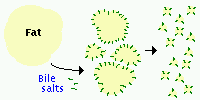The Journey Of a Cheese Sandwich
 •
by
•
by code0011
I was sitting in my room the other day, and I thought to myself, I could really use a cheese sandwich. So off I went into the kitchen, and there I made my sandwich. This is the story of that sandwich, right through to the very end.
We pick up this story as I am halfway through eating it. It is very tasty.
I raise the sandwich to my mouth and tear off a bit with my central incisors, and start chewing with my molars, going through the processes of physical digestion. At the same time, I am also mixing saliva with the food, which contains salivary amylase, which starts to break down the starch(a polysaccharide), into maltose(a disaccharide). before subconsciously forming the food into small bolus, or spherical lumps of food, which pass over the epiglottis, and then pass down my oesophagus.

After passing through the oesophagus, the bolus comes to rest in the stomach. Here, the stomach churns extremely fast, mixing hydrochloric acid with the food to kill all the bacteria, and pepsin, to begin the chemical digestion of protein. Slowly but surely food is let out by the sphincter in a continuous, albeit small, stream into the duodenum. Here bile is mixed with the food, and it turns any large lipid globules into an emulsion of tiny droplets.

This increases the surface area of the lipid, so that lipase enzymes can break it down more easily. At the same time sodium hydrogen-carbonate(mixed in with the bile) neutralizes the stomach acid to provide the optimum pH level for the enzymes to work. Also released are the pancreatic enzymes, which begin to digest chemically starch(amylase - maltose, maltase - glucose) , proteins(trypsin - peptide, peptidases - amino acids) and lipids(lipases – glycenol & fatty acids).
As the food continues along the the intestine, by peristalsis, more enzymes are added until all parts of the food that can be digested have been fully broken down into smaller soluble end products, that are possible to absorb. The last part of the small intestine is called the ileum, and it is highly adapted to absorb the chemically digested food. The ileum has a massive surface area to maximise areas to absorb the food, and it has many folds, all of which are covered in villi, small finger-like projections that are only 1-2mm long, but covered in microvilli.

Each villus has a network of blood capillaries to take digested food to the body, and a lacteal, to take all the fat droplets away, as if they were to go in the blood stream, they would cause clots. The lacteal forms part of the lymphatic system, and eventually lymph drains into the blood stream.
All the blood vessels from the ileum join to form the hepatic portal vein, which goes from the gut to the liver, where all the toxins are filtered out from the blood, and some molecules are built up and stored, such as glucose, is converted into glycogen and stored.
From the liver, all the digested molecules are transported around the body in the blood stream, and the soluble food molecules are absorbed into the cells, and used to rebuild parts of cells in a process called assimilation.
Having reached the end of the small intestine, almost all of the usable, digested food has been absorbed, and only the waste, such as indigestible fibre, and dead and living cells remains. This enters the first part of the large intestine, the colon, where almost all of the remaining water is absorbed, leaving a semi-solid lump of waste called faeces behind. This is stored in the rectum, before being ejected from the body through the anus.

She wants you to sub and vote
code0011
coming in the near future - The causes, effects and possible solutions to deforestation.


Comments
WTF?
My biology homework from a few years ago, typed up, with an obvious thing added.
LOL good one code lol's i vote😨D
Lolz funny
It's p obvious that this is my first attempt at writing articles
\(*-😉/
Its not bad not bad at all:3
I preferred the exterior view. (last pic)
tbh, I don't blame you. It's pretty boring stuff.
HA. I wonder how long this is going to last before admin removal? Still, hilarious. Makes me want to publish some of my History papers.
With the admins rate of reaction, about 400 years.
Who is this admin? We have plato now...LOL
we all know it's the same old admin with a different name
P. funny, nice article.
thanks \(*-😉/
At least the girl in the last pic isn't on the commode.
this article changed my life
glad to hear it
I always wondered... Thanks for the knowledge! Voted!